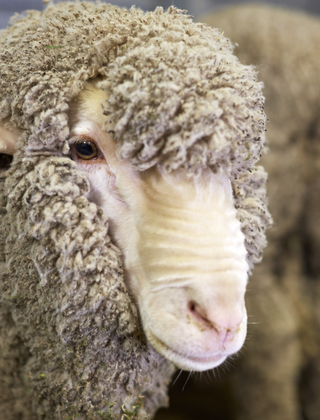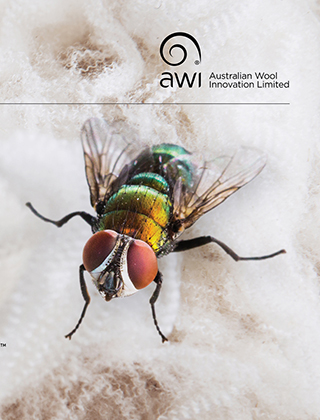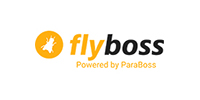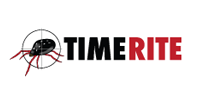Be prepared for flystrike season
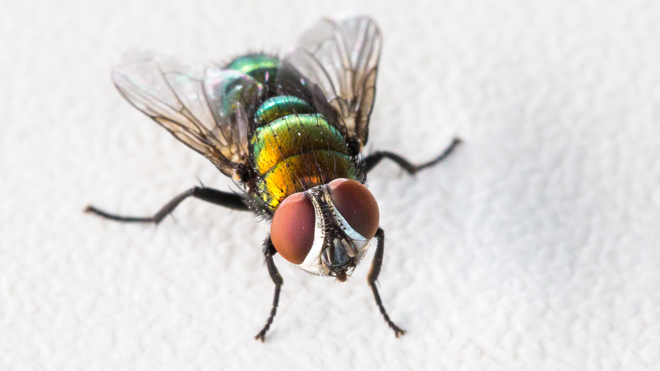
As we head into flystrike season, now is the time to implement your annual flystrike management plan. Early prevention of flystrike is key to minimising animal welfare and economic threats. The suite of resources in the AWI Flystrike Extension Program are now available for woolgrowers.
It is important to have a broad flystrike management plan which incorporates the following three aspects, but preventing flystrike is key.
- Prevention of flystrike
Selecting sheep which are less susceptible to flystrike is a key long-term approach to reducing flystrike risk. Short-term preventative activities include shearing or crutching to remove wool and dags, reducing the risk of scouring which causes dags, applying appropriate chemical treatments, careful selection of less flystrike-prone paddocks, and killing maggots and removing sources of protein. These strategies work best when used together as part of an integrated flystrike management program. See below. - Monitoring to detect flystrike
Monitor all mobs of sheep for signs of flystrike during higher-risk periods, but especially weaners. Monitoring involves a combination of checks including looking for flystrike in sheep, checking populations of flies, and checking weather conditions. - Treatment options when flystrike occurs
Make sure you use a combination of treatment activities and that you don’t rely on one single activity. It’s important to make sure all flystruck sheep are effectively treated, all maggots are killed, and sources of protein are removed, to aid the sheep’s recovery and break the lifecycle of flies to prevent additional strikes. Cull struck sheep as they are more likely to get struck again.
AWI Flystrike Extension Program
AWI’s Flystrike Extension Program is available to woolgrowers across Australia to improve the lifetime welfare of their sheep, reduce their reliance on mulesing and chemical use, and increase whole farm profitability.
All six components of AWI’s Flystrike Extension Program are now available to woolgrowers to support their flystrike management – see below.
Woolgrowers can pick and choose how to get involved with the different components of the program that best suits their requirements, sheep type, climate, operating environment and husbandry practices.
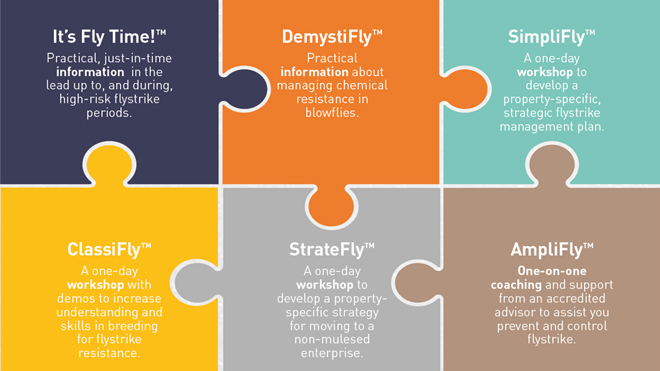
More information:
- Information on the above AWI Flystrike Extension Program is available at wool.com/flystrikeresources
- For information on SimpliFly™, ClassiFly™ and StrateFly™ workshops available near you, contact the AWI Extension Network in your state and sign up to their free newsletters. You can find your network at wool.com/networks or call AWI on 1800 070 099.
- Detailed information on flystrike management, including access to interactive decision support tools, is at flyboss.com.au
- Information on AWI’s flystrike research, development and extension is at wool.com/flystrike
What can I do to prevent flystrike?
Selecting sheep which are less susceptible to flystrike is a key long-term approach to reducing flystrike risk. This includes selecting for low breech wrinkle and wool cover and low incidence of dags and stain.
Culling sheep which have previously been struck is also advisable. The AWI and Meat & Livestock Australia publication Visual Sheep Scores is a useful tool to help select and cull sheep.
See the article on AWI’s one-day ClassiFlyTM workshop which increases woolgrowers’ understanding and skills in breeding for flystrike resistance.
Well-timed preventative strategies can help reduce the risk of flystrike and minimise the need for treatment. Short-term preventative activities which help reduce the risk of flystrike include:
1. Shear or crutch to remove wool and dags
Shearing and crutching are effective preventative activities which reduce the formation of dags and urine stain, and reduce wool length so the breech area dries more quickly.
Shearing and crutching can provide up to six weeks protection from body and breech flystrike. If sheep are scouring, this protection may be reduced to three weeks.
Shearing or crutching should be planned to coincide with the start, or just before the usual start, of the fly season. This is particularly important for lambing ewes that may have more stain around their breech.
Carefully consider the timing of shearing and crutching. Aim to extend the period of protection over the fly season as much as possible by ‘spacing out’ these activities, bearing in mind the usual high-risk periods for flies in your area.
2. Tail dock to the optimal length when marking lambs
When marking lambs, ensure tail length is appropriate to minimise stain around the breech and reduce flystrike risk throughout the sheep’s life. The recommended tail length for ewes is to ensure the healed tail covers the vulva. This means docking below the third or fourth palpable joint. Male lambs should have their tails docked to the same length as ewe lambs.
This is the optimal length to allow sheep to lift their tail to channel urine and faeces away from breech wool and use their tail to swish flies away. It also helps to prevent prolapse (common in sheep with very short tails) and protects soft tissue from cancers caused by sun exposure.
3. Apply preventative chemicals to sheep to protect against strike
Insecticides can be used in combination with other preventative activities to deter flies but they shouldn’t be relied upon alone.
These chemicals are registered to be used either as a preventative measure or to treat struck animals (‘dressings’). Some chemicals only provide protection and will not kill older maggots.
Wool length can impact the effectiveness of preventative chemicals. It is vital you use the right chemical for the task, and follow the label instructions to use effective chemicals in the right way.
Where possible, time applications to extend the protection period. For example, if you shear in early December, applying a preventative chemical six weeks later in mid-January can help to protect the sheep.
Use the ParaBoss Products Search tool, available at flyboss.com.au/sheep-goats/treatment/products.php, to work out the most appropriate preventative chemical and application method for your situation.
When considering a chemical treatment check for withholding periods and intervals. The law requires you keep accurate records of any chemical treatments used.
4. Reduce the risk of scouring which causes dags
Scouring can cause dags to form rapidly. Dags cause the wool and skin around the breech to stay moist and warm, providing an attractive site for flies to lay eggs and maggots to develop.
Preventing scouring and dags is an important step to reduce the risk of breech flystrike. Several species of internal parasite cause scouring while others, such as Haemonchus contortus (barber’s pole worm), do not. Monitoring the populations of worms which cause scouring using faecal egg counts and drenching when required can help reduce the risk of scouring.
It is also important to avoid sudden changes in diet that may induce scouring, such as the introduction of grain or forage crops.
5. Carefully select paddocks
Most properties have certain paddocks where sheep are at higher risk of flystrike (for example, protected creek paddocks or wet flats) and others where the risk is lower (for example, exposed paddocks with less ground cover, timber and wet areas, where sheep dry out rapidly and fly activity is low). A possible option during periods of high flystrike risk is to avoid the hotspots that encourage fly activity by moving high-risk flocks to the more exposed paddocks.
Avoid paddocks that may be contaminated with a large population of scouring worm larvae (for example, those that have been recently grazed) during the fly season to help prevent scouring.
6. Kill maggots and remove sources of protein
It is important to remove and dispose of any fleece or waste animal matter (dags, dirty wool pieces, horn tips, tails, etc) and, where possible, carcases, to eliminate these as a source of protein for both the Australian sheep blowfly and other flies. Household waste and protein-rich manure are other sources of protein to which flies are attracted.
Any maggots and maggoty wool removed from struck sheep should be collected, sealed in a plastic bag, and left in the sun for a few days to ensure the maggots are dead.
Flies do not generally travel far so reducing their numbers at a property level can make a significant difference to the incidence of flystrike on individual properties and in the local area.
No single prevention strategy should be relied upon alone. Make sure you use a range of well-timed strategies in combination.
More information:
This article appeared in the Spring 2025 edition of AWI’s Beyond the Bale magazine that was published in September 2025. Reproduction of the article is encouraged.






